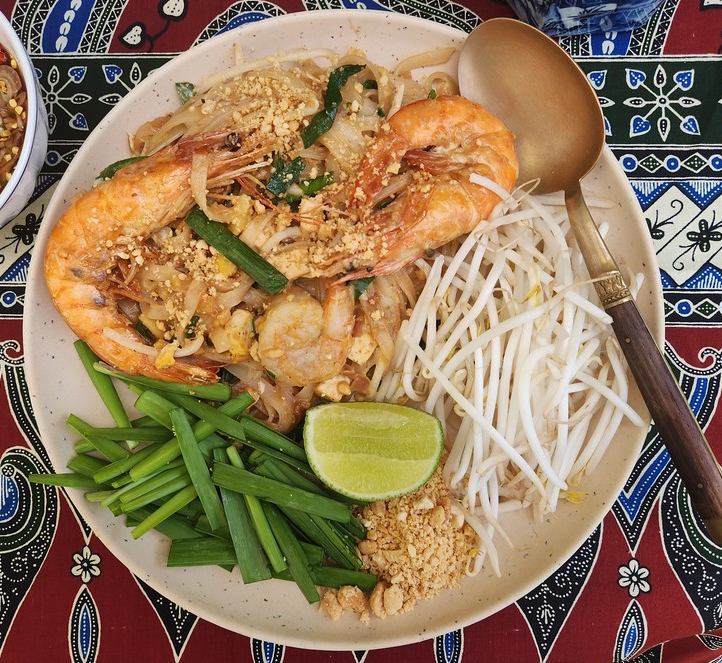
Our recipe of the month is for Chinese Chow Fun Noodles. Although most people associated Chinese cuisine with steamed or boiled rice, noodle made from either wheat or rice are also very common in Chinese cuisine. This recipe which uses wide rice noodles is easy to prepare, adaptable and absolutely delicious.
Long grain rice is a fundamental staple of China, particularly areas south of and along the Yangtze River. In addition to steamed or boiled, it is also commonly used to make noodles. The earliest evidence of noodles are for wheat noodles dating as far back as the Han Dynasty (203 BCE to 220 CE) and wheat noodle are still a staple of North China cuisine. It is not known exactly when noodle production reached the south. Historians and anthropologists theorize that they are introduced by invading armies from northern China. In order to adapt to the available crops of the south, northern cooks produced noodles using rice to placate the palates of their soldiers who were unaccustomed to eating plain rice. Whether or not this origin story is true, the noodles are popular throughout China today.
Chow Fun noodles (河粉) are a specific and more modern version of rice noodles. Like many rice-based noodles, the preparation of chow fun (or hor fun) begins with a ground rice and water mixture, which is then steamed into sheets and cut. Hor fun noodles are wide and flat. This particular style originates in southern China around the city of Guangzhou but today Chow fun noodles are eaten throughout Cantonese speaking China. They are commonly used in yum cha restaurants which serve dim sum. Since yum cha restaurants are extremely popular and often crowded, quick cooking methods like steaming, deep-frying and stir-frying are often employed.
The term "chow fun" denotes being stir-fried. This recipe can be prepared either "wet" or "dry". The wet version typically uses soy sauce, oyster sauce, pepper and sugar which produces a gravy that coats the noodles. Alternatively, dry frying the noodles using high heat creates a crust on the noodles. Wok hei (literally translated to "wok air") refers to the flavor created by the wok itself. In order to achieve this texture and impart this "essence of the wok" a carbon steel or cast iron wok is required. Non-stick and stainless steel versions won't allow for proper charring of the noodles. The dry version is the most common version found in Chinese restaurants (dim sum and otherwise) in the United States.
It is important to know that Chow Fun is first and foremost a noodle dish; therefore all other ingredients are secondary. The non-noodle ingredients should compliment, not obscure, the texture and flavor of the noodles.
As with so many stir fried dishes chow fun has an innumerable permutations. Depending on the cook it might be as simple as noodles and bean sprouts, or it can be a dish can be opulently garnished with high quality loin cuts of beef. I prefer the simple and common version of the dish made with flank steak and a handful of vegetables. This dish can be prepared with whatever ingredients one has on hand and is easily adapted to a vegetarian or vegan diet.
Notes:
1. When shopping for rice noodles for this dish try to find sheets that you can cut to a desired thickness. I prefer 1 inch wide noodles. If uncut sheets are not available, go with the widest fresh rice noodles you can find
2. Coating meat in a liquid (oil, water, soy sauce etc.) that has corn starch added to it is an essential Chinese cooking technique known as "velveting". It is used for both fried and boiled dishes. The technique retains the moisture in meats (and shelled or skinned seafood). This method results in the characteristic tenderness found in Chinese cooking.
Ingredients:
Chow Fun:
- 12 ounce fresh rice noodles
- 3 tablespoons of neutral cooking oil
- 3 thin slices of ginger
- 5 scallions, cut into 3/4 inch pieces
- 1 small yellow onion, finely sliced with the grain
- 2 teaspoon Shaoxing wine
- 6 ounces mung bean sprouts
- Salt and white pepper to taste
Beef Marinade:
- 6-8 ounces of flank steak, sliced into 1/8 inch thick pieces
- 1 teaspoon cornstarch
- 1 teaspoon light soy sauce
- 1 teaspoon Shaoxing wine
- 1 teaspoon oil
Stir Fry Sauce (for "wet" version):
- 2 tablespoons dark soy sauce
- 1 tablespoons light soy sauce
- 2 teaspoon oyster sauce
- 1 teaspoon sesame oil
- Pinch of sugar
Preparation:
- Heat the wok over high heat until it begins to smoke.
- add about 1 1/2 tablespoons of oil to the wok and swirl to coat.
- Add the marinated beef and sear until browned. Once browned remove from the wok and set aside.
- Add 1/2 tablespoon oil to the wok (optionally you can wipe out any remaining residue)
- Add sliced onion to the wok and cook, tossing occasionally, until softened and slightly browned.
- Remove and set aside onion.
- Add remaining 1 tablespoon of oil and ginger to the wok. Allow the ginger to cook form 15-30 seconds to infuse it's flavor into the oil.
- Add scallions to the wok and cook, moving the scallions around constantly.
- Add the fresh rice noodles to the pan and stir-fry on high heat, mixing evenly.
- Add Shaoxing wine around the rim of the wok and continue stir frying, constantly flipping the noodles to coat.
- If preparing the "wet" version add the sauce to the pan. If preparing the dry fry version add only oyster sauce and dark soy sauce.
- When noodles begin to char and are coated with sauce, return the beef and onions to the wok, stirring constantly, scraping the bottom of the wok as you fry. Make sure the wok is still on high heat to attain proper "wok hei" as you cook.
- Add bean sprouts and cook until just tender.
- Serve the Chow Fun immediately with chili oil or chili sauce on the side.
Recipe and photo by Liam Fox









